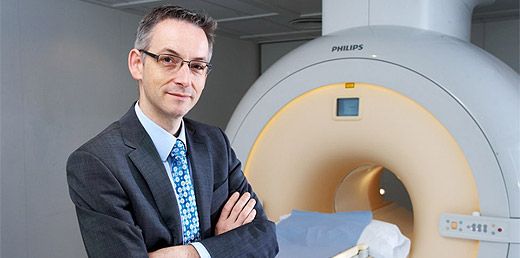
A magnetic resonance imaging (MRI) scan for coronary heart disease is better than the most commonly-used alternative, a major UK trial of heart disease patients has shown.
The findings by University of Leeds researchers could change the way that people with suspected heart disease are assessed, potentially avoiding the need for tests that are invasive or use ionising radiation.
Full results of the study, which was funded by a £1.3 million grant from the British Heart Foundation (BHF), are published online today by The Lancet medical journal.
Coronary heart disease (CHD) is a leading cause of death and disability. In the UK, an estimated 2.6 million people are living with the condition, costing the NHS £9 billion per year.
CHD is caused when vital arteries serving the heart become narrowed or blocked by a build-up of fatty substances. This can lead to severe chest pain, known as angina, and if the condition worsens and remains untreated, patients may have a heart attack.
Patients with chest pain who are suspected of having angina will typically be sent to hospital for further tests. These tests will confirm the diagnosis of CHD and help doctors decide on the best course of treatment, which may involve drug therapy, a balloon 'stretch and stent' procedure to open-up narrowings in the heart's blood vessels - or a heart bypass operation.
At the moment, patients with suspected angina are most likely to have either an angiogram - an invasive test where dye is injected directly into the heart's arteries - or a non-invasive imaging test called SPECT. Unlike MRI scans, angiograms and SPECT tests both involve ionising radiation.
A five-year study by University of Leeds researchers, involving 752 patients, has now shown that an MRI scan is a reliable way of detecting signs of significant CHD. The researchers also showed that MRI was better than SPECT at diagnosing CHD and at ruling out heart disease in patients who did not have the condition.
This is the first time that MRI has been compared head-to-head against the 'gold standard' tests for CHD in such a large group of patients. The results may now lead healthcare policy-makers to re-think guidance on the tests that patients with suspected CHD should be offered.
University of Leeds' Dr John Greenwood, who led the study, said: "We have shown convincingly that of the options available to doctors in diagnosing coronary heart disease, MRI is better than the more commonly-used SPECT imaging test. As well as being more accurate, it has the advantage of not using any ionising radiation, sparing patients and health professionals from unnecessary exposure."
"The MRI technique could be used widely and not just in the UK," Dr Greenwood added. "The scans were all carried out on a standard 1.5 Tesla scanner - exactly the type of MRI scanner that you would find in most hospitals today."
Professor Peter Weissberg, Medical Director at the British Heart Foundation, said: "For patients suffering with chest pains, there are a number of tests that can be used to decide whether their symptoms are due to coronary heart disease or not. This research shows that a full MRI scan is better than the most commonly used alternative - a SPECT scan using a radioactive tracer.
"MRI has the additional advantage that it doesn't involve radiation. At present, not all hospitals have the expertise to undertake such scans but these findings provide clear evidence that MRI should be more widely used in the future."
For further information:
Please contact the University of Leeds Press Office on +44 (0)113 343 4031 or email pressoffice@leeds.ac.uk
"CE-MARC: A Prospective Evaluation of Cardiovascular Magnetic Resonance and Single-Photon Emission Computed Tomography in Coronary Heart Disease" by Greenwood et al is published Online First in The Lancet: DOI:10.1016/S0140-6736(11)61335-4